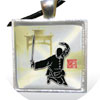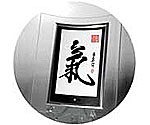The Eight Trigrams of the I-Ching (Yijing)
 |
An investigation of almost any culture, tradition, or religion will reveal the use of symbols to convey meaning beyond what is easily communicable in spoken or written language. The phrase "a picture is worth a thousand words" has proven true since time immemorial. In China, one widely recognized group of symbols that holds deep meaning in Chinese philosophy is the "Pa Kua" ("Bagua" in Pinyin) or "Eight Trigrams."
Most Westerners who are somewhat familiar with Chinese philosophy will recognize the eight trigrams as the building blocks that form the 64 hexagrams of the I-Ching or Book of Changes. However, the majority of I-Ching texts available today in English dive directly into commentary on the hexagrams without fully explaining the meaning and usage of the trigrams.
An understanding of the eight trigrams and the two primary trigram arrangements can provide great insight into a study of the I-Ching and facilitate a deeper understanding of the patterns of change inherent in nature and in human life. This article will briefly look at the history, meaning, and usage of the eight trigrams as arranged in the Fu Hsi (also called Hsien T'ien) and King Wen (also called Hou T'ien) diagrams.
The trigrams are essentially codifications of naturally occuring processes. By combining symbols that reflect dynamic elements in nature and the human process, the Chinese have sought to understand and predict patterns, cycles, and polarities which are present in nature and human development. Two such trigram combinations, the Hsien T'ien T'u and the Hou T'ien T'u, represent the balance of polar elements and the nature of cyclical change, respectively.
By studying the relationships of the trigrams in these configurations, one can learn to apply these symbols to individual development and gain insights into past and future events. Through identification with the trigram arrangements and the natural development process, one can adapt to fit smoothly into patterns of nature and seek balance within cycles of growth.
History
Trying to strictly define the source of any Chinese philosophical or religious concept is an exercise in frustration. Because so many traditions, customs, cultural influences, religions and philosophies in China are overlapping, and because the majority of Chinese history prior to 776 B.C. is legend, it is almost impossible to trace the exact source of any particular practice or concept. As an example, while writing on the "Background of the Book of Change" in his book I Ching: The Book of Change, John Blofeld has this to say on the subject of Chinese religion:
"In China, a clearcut distinction was seldom to be made between separate duties to the family, to the state and to the Gods - all of them being considered as overlapping parts of a single whole. Similarly, few Chinese make much distinction between one religion and another. We are apt to speak of a Chinese acquaintance as being a Confucian and/or Taoist and/or Buddhist; whereas he, if for once he ponders the matter deeply, may smilingly confess that he is all of those and something more as well; for there are whole segments of the traditional Chinese religion which fit into none of those categories; they have most curiously existed for several thousand years without even acquiring a name! When an elderly or middle-aged Chinese refers to his Chiao (religion)--which, by the way, is remarkably seldom--he is generally speaking of a highly individual compound of Confucian, Taoist and Buddhist ingredients (and others even more ancient but nameless) which happens to suit himself."


 Imprinted Apparel
Imprinted Apparel


 Framed Calligraphy
Framed Calligraphy Caligraphy Jewelry
Caligraphy Jewelry Paperweights
Paperweights Proverbs & Quotations
Proverbs & Quotations Bible Verses
Bible Verses Moringa Products
Moringa Products